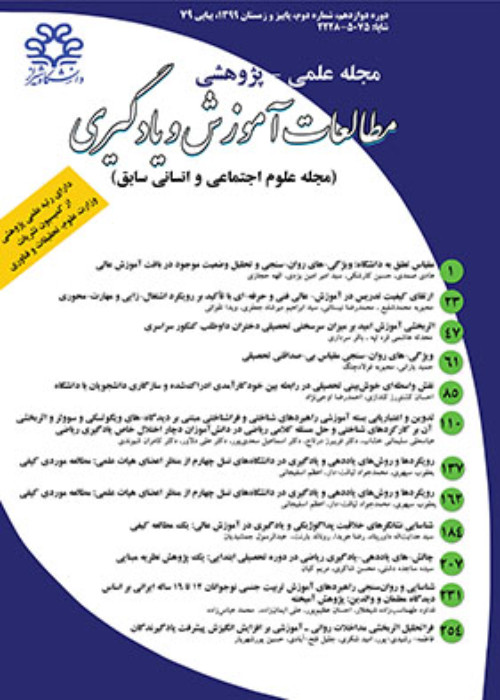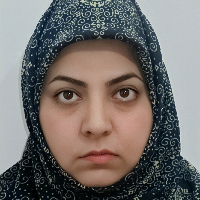Comparing the Effectiveness of Cognitive Self- Instruction and Peer Tutoring on Academic Achievement, Math Anxiety and Attitude towards Mathematics
Author(s):
Abstract:
IntroductionIn recent years mathematics has been considered an important issue that affects everybody's life, as it is an essential aspect of all the areas of daily life. Although high achievement in mathematics can be the best predictor of success in economic situations, for many students mathematics is accompanied with the memories of trial and error, frustration, and fear of incorrect responses to math questions. Some studies have indicated that certain instructional strategies can create more anxiety in students. Students suffering from such an anxiety believe that their anxiety comes from their math teachers, math misconception and their weaknesses in math assignments. The traditional class with its three specific characteristic; that is, the imposing power of the teacher, public exposure and time limitation, is the main factor of low achievement, high anxiety and negative attitudes towards mathematics. TIMSS results have showed that Iranian students are in the lowest grade of math. New perspectives in math teaching put emphasis on cooperative learning, problem solving, exploring, action, self-instruction and self-assessment. Peer-tutoring and cognitive self-instruction methods are two constructivist perspectives with a background of theories like role-taking and self-regulation learning that enable the students to manage their learning, cooperate with others, reinforce their self-control and have self-reflection. Children actively construct their own solutions to mathematical problems. Self-instruction can be defined as the ability of an individual to cognitively plan, organize, direct, reinforce, and evaluate one's own independent learning without a teacher's prompting. There are three powerful influences behind self-instruction: the learning and modeling of materials, the ability of verbalization and self-regulation (metacognition). Peer-Tutoring is also a system of instruction in which learners help each other and learn (themselves) by teaching; a peer tutor is anyone who is of a similar status as the person being tutored.These factors may lead to high achievement in math and modify the student's attitudes towards mathematics. Finally, there is mounting research evidence to suggest that low-achieving students may receive moderate benefits from peer tutoring and cognitive self-instruction approaches. So, the purpose of the present study was to compare the effectiveness of Cognitive Self- Instruction and Peer Tutoring as new math instructional methods on math achievement, math anxiety and attitudes towards math in the fifth grade female students.Research Questions This study put forward the following questions:1. Do peer-tutoring and cognitive self-instruction have any impact on math achievement?2. Do peer-tutoring and cognitive self-instruction have any impact on math anxiety?3. Do peer-tutoring and cognitive self-instruction have any impact on aattitudes towards math?MethodsThe research design was quasi-experimental with pre-posttest format. The participants were three intact classes including 54 fifth grade female students (age = 11) that were selected through accessible sampling and were randomly placed in one control and two experimental groups. For data collection several instruments were used: the Mathematics Anxiety Scale for Children, Chiu and Henry (MASC, 1990)(including 22 items with four subscales (learning math anxiety, math problem solving anxiety, math teacher anxiety and math assessment anxiety) with the reliability indices of 0.95 and 0.95 (in pre and post-test); Aiken Attitudes Towards Mathematics Scale (AATM, 1970) including 23 items with four subscales of enjoying, motivation, caring and fear of math and with the reliability indices of 0.96 and 0.83 (in pre and post-test), and Math Achievement Test including 15 items with the content validity being verified by the fifth grade teachers. First MASC, AATM and math achievement test in pre-test were used. Then two treatments consisting of peer-tutoring and cognitive self-instruction were employed in two experimental groups during ten sessions of 45 minutes. Instructional methods were explained in a teaching package consisting of the purpose, procedure and quality of teaching as well as some examples. No treatment was used in the control group. After treatment, MASC, AATM and math achievement test were used as post-tests. The collected data was analysed through Covariance analysis and Bonferroni Post Hoc test in SPSS-16.ResultsThe results of ANCOVA and Bonferroni Post Hoc test showed that there was no significance difference between the cognitive self-instructional method and peer-tutoring method in terms of mathematical achievement. Similarly, there was no significance difference between the cognitive self- instructional method and peer-tutoring method in the attitudes towards math. However, there was a significance difference between the cognitive self-instructional method and peer-tutoring method in math anxiety. Finally, both the cognitive self-instructional group and peer-tutoring group in comparison to the control group had higher mathematical achievement, lower math anxiety and better attitudes towards math.Discussion and ConclusionThis study was conducted with the goal of comparing the effectiveness of Cognitive Self- Instruction and Peer Tutoring as new math instructional methods on math achievement, math anxiety and attitudes towards math. It can be concluded from the study that Cognitive Self- Instructional Method significantly decreases math anxiety and improves math attitudes but is not significantly effective on math achievement. Also, it can be mentioned that peer tutoring improves the attitude of students towards math. The limitations of this research were: multiplicity of teachers and lack of control of their attitudes toward math. Hence, it is suggested that future studies take such issues into account. Because the elementary math is basic to the development of knowledge of math, new math instructional methods that reinforce cooperative learning, cause positive attitudes towards math and lead to achieving high grades in international evaluations, are necessary. As such, more attention should be paid to strategies of math instruction and to other sources of high achievement in mathematics. Instruction should not be based on extreme positions, that students learn solely by internalizing what a teacher or book says or solely by inventing mathematics on their own.
Keywords:
Language:
Persian
Published:
Studies in Learning & Instruction, Volume:4 Issue: 2, 2012
Page:
137
magiran.com/p1151256
دانلود و مطالعه متن این مقاله با یکی از روشهای زیر امکان پذیر است:
اشتراک شخصی
با عضویت و پرداخت آنلاین حق اشتراک یکساله به مبلغ 1,390,000ريال میتوانید 70 عنوان مطلب دانلود کنید!
اشتراک سازمانی
به کتابخانه دانشگاه یا محل کار خود پیشنهاد کنید تا اشتراک سازمانی این پایگاه را برای دسترسی نامحدود همه کاربران به متن مطالب تهیه نمایند!
توجه!
- حق عضویت دریافتی صرف حمایت از نشریات عضو و نگهداری، تکمیل و توسعه مگیران میشود.
- پرداخت حق اشتراک و دانلود مقالات اجازه بازنشر آن در سایر رسانههای چاپی و دیجیتال را به کاربر نمیدهد.
In order to view content subscription is required
Personal subscription
Subscribe magiran.com for 70 € euros via PayPal and download 70 articles during a year.
Organization subscription
Please contact us to subscribe your university or library for unlimited access!



